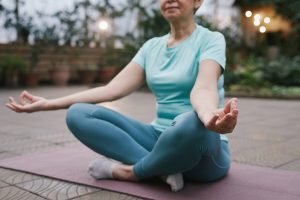Last updated on November 21, 2022
Transformation is a BIG topic—from social media to the world of coaching and therapy—AND it is a bit elusive.
Here is why:
Most of us think of transformation as the weekend warrior work with Tony Robbins or Landmark Forum. You get filled with new information, someone shares all the ways you feel inside but haven’t had the words to express, and you even allow yourself to be challenged.
You share your feelings in front of 50 people; you shed tears and leave feeling free, open, and vulnerable. You feel terrific for about one week, and Monday comes around, your car doesn’t start, your partner yells at you, and you find yourself sitting in traffic with all the negative emotions creeping back in.

What happened to the warrior?
First off—let’s get this out of the way—this is NORMAL. Secondly, you did have a moment of change, and you experienced what all humans experience (even if only for a moment or a week). You had a shift in the way that you are living. You had a few moments of believing it could be different and a moment of feeling truly different.
Transformation, at its core, is fleeting unless practiced and generated.
Transformation is about changing the very form or nature of something.
Transforming ourselves is a lifelong journey that inhabits all of us. It requires us to shift beliefs about who we think we are, and who our families, our friendships, and our community believe us to be. Rather than be limited to our own beliefs or those impressed upon us by others, we can choose who we are and then live who we are from our essence. Our Essence—our authentic self from source.
The Path to Transformation Starts with Small Changes
“Transformation” carries the hefty connotation of an enormous investment of energy and self—and that, right off the bat, can be enough to scare us away. Yet look at the transformations we can achieve when we commit to the process:
- All of who we are and are not.
- Noticing our being and others.
- Practicing service and acknowledgment in ourselves and others.
- Noticing love and allowing it.
- Separating our life force and our experiences.
Transformation, at its core, is fleeting unless practiced and generated.
Transformation is about changing the very form or nature of something.
Fortunately, our road to transformation starts first with change. “Change” is defined as a substitute or replacement. We begin changing by replacing unhealthy habits with healthy habits, such as…
- Starting your day with water with lemon rather than coffee.
- Going to bed 30 minutes earlier.
- Writing a gratitude list.
- Creating a manifestation list and taking small steps toward your manifestation.
- Choosing from your heart (not your mind).
- Finding a hobby or something creative to work on.
- Creating space in your life/home for a relationship with Self and others.
Not sure where to begin with habit changing? Create a drawing of a garden with your favorite flowers and weeds.

Name the flowers in your life, then name the weeds in your life. This visualization will help you focus on cultivating the flowers and pulling the weeds.
Motivations for Transformation
You’ve identified the ‘weeds’ in your garden. You know what you want to change. For many of us, what’s driving our will to transform aligns with one of these common themes:
You only get one life.
I often ask my clients to subtract their age from the average age we die, which is 82. That number will give you the number of summers you have left to enjoy life fully. While that may seem a bit dark, it begs the question of how long we want to live disconnected from ourselves and others, and what quality of life we want to live.
This new perspective allows us to imagine the impact we want to make in the world—first and foremost, the effect on ourselves. When we can visualize not only how we want to feel and experience ourselves but also how we impact others, the potential for transformation is powerful. When we heal and transform our lives, we are transmuting seven years of generations behind us and seven generations ahead of us. Your shift will reverberate in your children and affect who they are for their children. How your transformed self interacts with your parents will undoubtedly change how they are in their final years of life.
You have dreams.
We all have dreams of becoming what we wanted when we were nine: firemen, policewomen, astronauts, athletes, writers, teachers, and so on. We can admit that we may not become a firefighter at the age of 45. However, we must look underneath the label of the job and feel into what that nine-year-old deeply wanted. Most likely, they wanted to have an impact, and they wanted to feel like they were making a difference and being a hero. Your dream of being a hero and having an impact is not determined by what you do; rather, it is about who you ARE.
- How do you feel about who you are in your daily life?
- What would change if you felt your life was purposeful?
- What does a purposeful life look like, and how does it feel?
You are tired of being run by scarcity and fear.
Most of us outsource our desire for safety by externally controlling the environment around us. We tell ourselves, “If I can manage my partner’s behavior, then all will be okay” or “If I can keep life precisely as it is by staying the same, then all will be okay.” Keeping all copacetic so we can feel safe is a coping mechanism of Ego. Changing our relationship with our Ego creates new pathways to our relationship to fear and scarcity.
Scarcity and Fear is a worldview adopted to protect us from all of the ‘bad’ in the world. Fear and Scarcity are the protectors of our Ego. Our Ego’s job is to protect us from being disappointed, sad, scared, hurt, and afraid of change.
The problem comes when our Ego protects us from ourselves. Innately there is nothing to fear. However, our little self (still running the show) doesn’t know this, and therefore we are running on beliefs and patterns from a smaller version of ourselves.
Ego tricks:
- Befriend your Ego – How does your Ego sound? Act it out.
- Laugh at it – Oh, there you are, I see you! Be playful with your Ego, giggle.
- Move your body – Gesture with your body the way your Ego sounds.
- Temper tantrum – Allow yourself to shake, scream, and cry to move the energy out of your body.
As you begin this practice, you will notice more of what you desire and a greater presence in your daily life. As we start reshaping our worldview, we can begin claiming who we are authentically.
The Physical Impact of Transformation
As you begin to change, you will feel a difference in your body. Your body has already felt the response that your mind is now catching. Change is powerful; you are altering your reality and creating a new reality.
Your nervous system is the source of all transformation. When our core needs of acceptance, safety, and attachment are not met, it compromises our core self. When the body, mind, and spirit are operating in disjointed and disconnected ways, we get physical symptoms we can’t figure out; life crises that repeat themselves repeatedly; patterns, habits, and addictions we can’t break. We experience a lack of self-compassion and acceptance and have trouble figuring out where we’re going or why we’re here.
Through reconnecting to our body and spirit and learning to observe and direct the mind, we remember who we are and what our potential is. We are no longer cut off from the innate goodness that allows us to feel happy, joyful, present, and satisfied with ourselves and our lives.
Change is powerful; you are altering your reality and creating a new reality.
In other words, when we no longer need to run from our pain and wounding, what we find is a kind of Freedom that surpasses a life without pain because it allows us to find joy, love, connection, and compassion inside of—rather than in spite of—life’s difficult moments.

The concept of embodiment refers to how present or grounded in our bodies we can be at any given moment.
For those living with chronic or traumatic stress, being inside our bodies often feels more like a war zone than a haven.
We might feel overwhelmed and tense. We might feel numb and shut down, perhaps even dissociate. But regardless of how our experiences show up in our bodies, one thing remains the same: being “inside ourselves,” with our thoughts, feelings, and emotions, feels scary, confusing, and painful.
When we feel fully confident in our ability to navigate the worlds inside and outside of us, our bodies and the feelings and experiences they contain start to feel like home. Purposefully creating a sense of safety, security, and vitality inside ourselves after trauma, loss, or crisis can be likened to “returning home,” a journey of reclamation.
How We Create Transformation
It starts with knowing transformation is not a destination but a journey. It requires understanding that change is our first step towards transformation and that you allow yourself and others ‘humanity’ and be responsible for all of it: the good, the challenging, and the miracles.
The planet is full of people with limited self-awareness and insight. All we can do is notice it, share it, and practice it. Possibilities are infinite, so wherever you are, there will always be something to transform.
Life is a lot more fun when there is vitality and deep satisfaction when you begin living the transformative way, and it is a way of being full of possibility and the unknown that keeps us transforming our lives.
Editor’s Note: A while back we featured Jennifer as one of our Featured Coaches. You can read our interview with her here.

Jennifer Lovely
Jennifer Lovely is an Ontological Coach, Somatic Practitioner, Transformation Breath Practitioner, Yoga Therapist, Yoga 12 Step Facilitator, Movement (Pilates) Teacher, Student of consciousness transmission (primarily influenced by Carlos Castaneda and his colleague Teo Alfero), and a Student of Gabor Maté’s compassionate inquiry. Jennifer works with women to transform their relationships with themselves, supporting them in finding their gifts in their wounds and by Reclaiming Grace as a Self-Love Revolution by disobeying the beliefs that we were taught as children.
















Be First to Comment